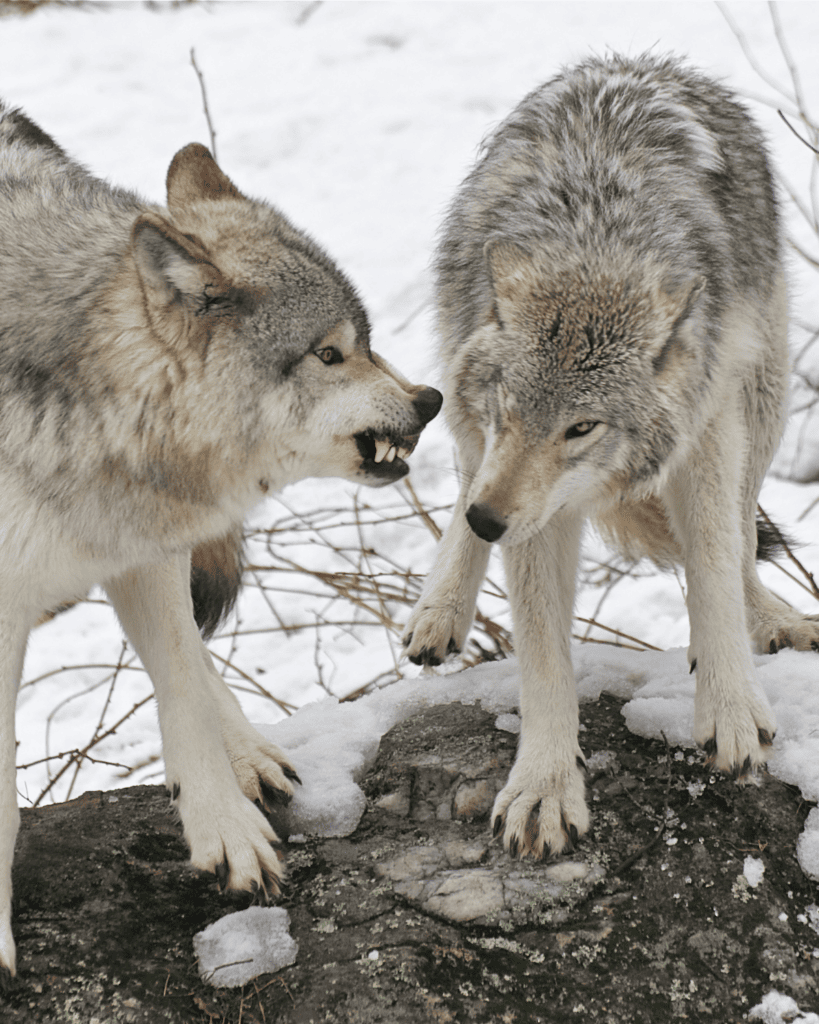Dominance theory is a controversial concept in dog training that has been popular for decades – and it’s caused so much confusion in the industry. So what’s the truth?
It assumes that dogs are constantly challenging their owners for dominance and that owners must use forceful techniques to establish themselves as pack leaders. The theory advises owners to use punishment, coercion, and other dangerous methods to gain control over their dogs.
While dominance theory used to be widely accepted, it has since been largely discredited by modern veterinary behaviorists, animal behavior scientists, and positive reinforcement dog trainers. There is now a substantial amount of evidence that dominance theory is based on flawed assumptions about wolf and dog behavior. Furthermore, techniques derived from dominance theory often lead to increased fear, anxiety, and aggression in dogs. They can damage the human-canine bond.
The purpose of this article is to explain what dominance theory entails, analyze why its premises are inaccurate, and reveal the risks of dominance-based training. We will examine more effective, science-based methods that allow owners to build trust and understanding with their dogs. Our goal is to debunk the myth of dominance and help owners adopt humane, reward-based training instead.

History of Dominance Theory
The concept of dominance in dog training originated in the 1940s and was popularized by veterinarian John Paul Scott and animal behaviorist John Fuller. They conducted studies on wolves in captivity and concluded that wolves have a strict hierarchical social structure, with an “alpha wolf” asserting dominance over subordinate wolves.
Scott and Fuller believed this social structure also applied to domestic dogs since they evolved from wolves. They theorized that behavior issues in dogs were due to a lack of human dominance in the relationship. This launched the notion that owners must dominate their dogs to gain respect and obedience.
In the 1970s, dog trainer Richard Abrantes expanded on dominance theory in his book “Dog Language.” He instructed owners to use physical corrections and punishment to establish their alpha status. His methods influenced popular trainers Barbara Woodhouse, the “Queen of Dog Trainers,” and Cesar Millan, the “Dog Whisperer,” who promoted and popularized dominance techniques to mainstream audiences through books and television.
Dominance theory became pervasive in dog training, with many trainers asserting owners must use forceful corrections to gain a dog’s respect, enforce their status as pack leader, and address behavior issues stemming from a dog’s attempt to gain dominance. This notion persisted for decades as the standard model for dog training and ownership.

What Dominance Theory Claims
Dominance theory arose from research on wolf packs in the 1940s, which proposed that wolves organize themselves into hierarchical packs with dominant alpha animals at the top. When applied to dogs, dominance theory claims that dogs are continuously challenging humans for control and authority.
Dominance theorists believe that dogs engage in behaviors like barking, jumping, nipping, growling, or not following commands in an attempt to assert dominance over their human owners. The theory states that dogs view themselves as alpha over humans in the household and will behave aggressively or disobediently in order to maintain their dominant status.
According to dominance theory, dogs who exhibit “dominant” behaviors are doing so to undermine the authority of the human and elevate their own status. Dominance-based trainers claim that owners must correct these behaviors by using forceful, coercive training methods to assert their dominance over the dog. This includes things like alpha rolls, collar corrections, physical punishment, and other methods intended to establish the human as the pack leader.
The core principle is that dogs are continuously trying to control their owners and people must maintain alpha status through physical means. Proponents of dominance theory believe it is the nature of dogs to assume they are dominant over humans unless shown otherwise through confrontational, authoritarian training.

Why Dominance Theory is Flawed
Dominance theory emerged from flawed studies in the 1940s and 1960s that did not use scientific rigor. The theory is based on observations of wolves in captivity, not dogs in family homes. Early dominance theory studies involved forced interactions in artificial packs of unrelated wolves. These studies have since been widely discredited for poor experimental design and misinterpretation of normal canine social behaviors.
In contrast, modern studies of wild wolf packs show that wolves do not always organize themselves in strict dominance hierarchies. Instead, they show flexibility in leadership and social relationships based on context and need. Dog behavior is even more complex and nuanced than wolf behavior due to thousands of years of domestication.
Dominance theory wrongly assumes dog behavior is driven by a desire for highest rank in a rigid hierarchy. However, dogs do not have a notion of dominating their human family members. Their motivations are much simpler, such as getting attention, rewards, or access to things they want. While dogs are capable of competing with each other and displaying resource guarding or reactive behaviors, those behaviors stem from fear and insecurity rather than a calculated desire for power and control.[3]
In reality, the parent-child dynamic better represents the human-dog relationship. Just like human children, dogs look to their guardians for protection, care, guidance, and support. They do not plot to somehow take over the family.[4] Dominance theory creates an adversarial dynamic that damages trust and understanding between humans and dogs.

Negative Impacts of Dominance Theory
Dominance theory can have serious detrimental effects on a dog’s behavior and wellbeing. The techniques associated with dominance training often involve asserting dominance and physical force to make the dog “submit.” This can include things like alpha rolls (forcefully rolling the dog onto its back and holding it down), scolding, leash corrections, and other forms of punishment.
Relying on dominance and punishment in training has been shown to actually increase aggression and anxiety in dogs. This is because physical force and intimidation teaches the dog that humans are scary and should be feared. The dog is put on the defensive, feeling the need to protect itself from threats. This destroys the bond of trust between owner and dog.
Studies have found higher rates of aggression in dogs trained with dominance-based methods compared to dogs trained with positive reinforcement. Dogs trained with physical force are also more stressed, show more fearful behaviors, and respond more defensively.
Dominance techniques force compliance without addressing the underlying cause of unwanted behaviors. They suppress behaviors temporarily through fear rather than teaching the dog healthy alternatives. This can cause the undesirable behaviors to reemerge or worsen over time.
Positive reinforcement training is recommended over dominance methods. Reward-based training builds confidence and trust while setting the dog up for success. It preserves the human-animal bond while improving behavior through patient, compassionate guidance. Ultimately, the most effective and ethical way to train a dog is by proving guidance, not asserting dominance.
Modern Views on Dog Behavior
In the past two decades, there has been an increasing shift away from dominance theory and towards kinder, more effective methods for training dogs based on scientific research on canine behavior and psychology. Rather than viewing dogs as constantly vying for dominance and needing to submit to human authority, modern experts recognize that dog behavior is primarily driven by instinct, early life experiences, environment, and learning history.
Some key insights from modern dog behavior research include:
- Dogs are not wolves. Research shows domesticated dogs separated evolutionarily from wolves over 10,000 years ago and have very different social structures and instincts. Wolf pack hierarchy does not apply to our pet dogs.
- Dogs do not see humans as part of their pack. The notion that dogs compete with humans for dominance has no factual basis. Dogs form social attachments and bonds, not linear hierarchies.
- Many perceived “dominant behaviors” in dogs stem from fear or anxiety, not a desire for control. For example, aggression when guarding food or toys often reflects a lack of proper socialization, not deliberate disobedience.
- Positive reinforcement training is more effective for teaching dogs than punishment, dominance, or asserting authority. Setting clear rules and boundaries combined with rewards for good behavior works better than scolding, physical corrections, or alpha rolls.
- Every dog has a unique personality shaped by genetics and life experiences. There is no one-size-fits-all approach. Training should be tailored to each dog’s unique needs, temperament, and motivations.
- Relationship-based training focused on two-way communication, mutual trust, and meeting a dog’s emotional needs leads to better results and a stronger human-canine bond.
Rather than outdated dominance models, modern dog experts emphasize positive, personalized training approaches focused on proven techniques like desensitization, counterconditioning, management of antecedents, and reinforcing desired behaviors. Research shows this compassionate, holistic style achieves excellent dog behavior outcomes without harming the human-canine relationship.

Recommended Positive Training Methods
The use of positive reinforcement and rewards is the recommended approach for humane, effective dog training. This method focuses on reinforcing desired behaviors and avoids the risks of dominance-based training.
Positive reinforcement training relies on giving a dog rewards like treats, praise, or play when they demonstrate the behavior you want to see. This helps the dog associate that behavior with something pleasant, making them more likely to repeat it. The reward should be given as immediately as possible after the desired response.
Some of the main techniques in positive reinforcement training include:
- Clicker Training – The click of a clicker marks the precise moment the dog does the right thing. This clear signal helps the dog understand which behavior earned the reward that follows. The clicker serves as a bridge between the behavior and treat.
- Lure Training – A treat is used to lure the dog into following it with their nose into the desired position, like a sit. Rewarding frequently at the start can shape this behavior. The lure fades over time.
- Shaping – Rewarding incremental steps that gradually get closer to the end goal behavior. For example, rewarding a puppy for looking at the leash, then moving toward it, then touching it with their nose, building up to allowing you to clip it on.
- Capturing – Waiting for the dog to offer a desired behavior on their own, then marking and rewarding it. For example, when your dog lies down, you can mark that with a clicker or word like “yes!” and reward it.
- Prompts – They serve as a cue for a dog to perform a learned behavior that has been reinforced consistently. For example, prompting a dog to lie down by giving the verbal cue like “down.”
Positive training focuses on reinforcing good behaviors rather than punishing bad behaviors. It sets dogs up for success and strengthens the bond between dog and owner. Proper timing, consistency, patience and understanding dog psychology are key to effective positive training methods.

Signs of a Good Dog Trainer
When searching for a qualified dog trainer, there are certain credentials and approaches you’ll want to look for. Here are some signs that a trainer uses science-based, humane methods:
- Certified Professional Dog Trainer (CPDT) – This is one of the most respected certifications in the field. CPDTs must pass a rigorous exam on dog training and behavior and adhere to ethical standards. They stay up-to-date through continuing education – this said, there has been a recent trend that the CPDT aren’t monitoring their members sufficient.y So still look out for red flags.
- Certified Applied Animal Behaviorist (CAAB) – CAABs have graduate degrees in animal behavior science and many years of experience. They use behavior modification methods rooted in scientific research.
- Certified Dog Behavior Consultant (CDBC) – Founded with the IAABC, the CDBC is an American qualification showing that the individual has sufficient knowledge to deal with behavioral issues.
- Institute of Modern Dog Trainers (IMDT) – the IMDT are a British institution who offer high quality training to dog trainers.
- Positive reinforcement techniques – Good trainers use reward-based methods to teach dogs desired behaviors, avoiding punishment or dominance. They focus on building a bond through patience, consistency and motivational tools.
- Customized approach – They tailor the training plan to your dog’s unique needs, abilities and preferences. Force-free choices are provided.
- Education focused – The priority is equipping you with the knowledge and skills to train your dog long-term. A good fit between client, dog and methods is ensured.
- Patience and empathy – Training takes time. A good trainer is understanding and keeps sessions upbeat through incremental successes. Harsh corrections are avoided.
- Open communication – They welcome questions, explain concepts clearly, and describe how and why techniques work. You should feel comfortable and involved.
The right dog trainer can make all the difference in creating a happy, confident dog. Focus on positive reinforcement, customization and strong communication when choosing one. With an ethical, certified trainer, you and your dog will be on the path to training success.

Frequently Asked Questions
Q – Does dominance theory work for training dogs?
No, dominance theory has largely been debunked as an effective or humane way to train dogs. While it was once believed that dogs were trying to assert dominance and that force-based techniques like alpha rolls were necessary, we now know dogs don’t think in terms of social hierarchy. Harsh punishment can actually cause behavioral issues in dogs. Positive reinforcement training is a much more effective approach.
Q – Do dogs need an “alpha” or pack leader?
Dogs do not need or benefit from a rigid alpha/leader. Research shows dogs do not actually form social hierarchies like wolves. While dogs need guidance and structure, like any family member, the healthiest relationships are based on mutual trust and respect, not forced dominance. Set rules and boundaries, but also nurture your dog’s autonomy.
Q – Is it okay to physically punish a dog for bad behavior?
No, physically punishing dogs for bad behavior is not recommended and can make problems worse. Techniques like hitting, alpha rolls, and other forms of intimidation do not address the root cause of behavior issues. They also break trust between dog and owner. Positive reinforcement training is much more humane and effective for curbing bad habits.
How can I establish leadership without dominance?
You can establish leadership by providing structure, guidance, and boundaries for your dog. Use rewards to reinforce good behaviors and limit their ability to fail. Set and stick to a routine. Give clear commands. And aim to build a bond of trust, not fear. Your dog will look to you for direction without forced dominance. Leadership is about being the teacher, not the dictator.
What Are Signs Of A Bad Dog Trainer?
Signs of a bad dog trainer include: reliance on dominance theory, use of punishment/intimidation, no certification, encourages confrontational techniques, blames the dog’s breed, makes guarantees, and lacks knowledge of animal behavior science. Good trainers use patience, not physical force. They have credentials and focus on positive reinforcement.
Dominance is Dead.
Dominance theory has historically been a popular framework for understanding dog behavior and training dogs. However, as this article has shown, there are several reasons why this theory is flawed and should be avoided:
- Dominance theory incorrectly assumes dogs are constantly competing for dominance in a rigid hierarchy. Research shows dog social behavior is much more flexible and nuanced. Dominance displays are situational, not a fixed personality trait.
- Punishment-based techniques associated with dominance theory, like alpha rolls and physical corrections, are risky and can backfire by increasing a dog’s fear and anxiety. This can lead to more behavioral issues.
- Dominance theory causes people to misinterpret normal dog behaviors as attempts at control or domination. This leads owners to unnecessarily and harshly punish dogs for behaviors like getting on furniture, walking ahead on leash, etc.
- Dominance theory has spread the damaging myth that all behavior issues stem from the dog’s quest for dominance. In reality, most problem behaviors are the result of normal canine instincts, lack of training, improper training, or fear/anxiety.
- New scientific research shows dog training based on positive reinforcement is safer and more effective. Reward-based methods build trust and better communicate how owners want dogs to behave.
All in all, dominance theory is an outdated way of understanding dog behavior that can harm the dog-human relationship. While still prevalent in some circles, a growing body of research confirms it should be abandoned in favor of modern, scientifically-sound training methods. The path to a well-behaved companion begins with leaving the myth of dominance behind.






0 Comments